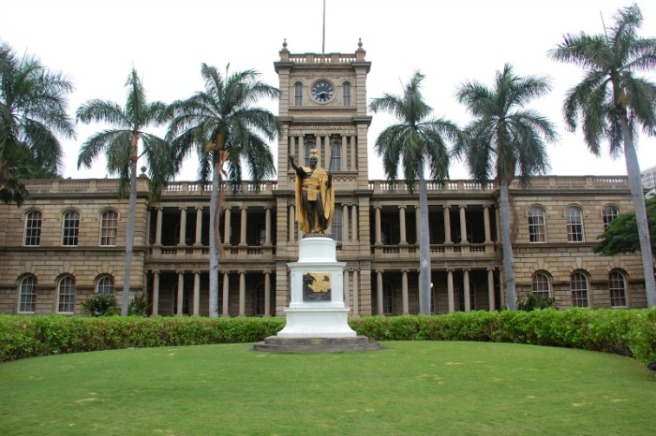Second day in Oahu, Hawaiian Island.
30th Nov
We woke up as early as 4 in the morning to visit Pearl Harbor Memorial. In holiday season tickets for USS Arizona memorial tour are limited and are sold quickly. The park opens at 7 but according to my hubby the queue starts as early as 6. We got ready and had ‘everything bagel’ and coffee at a cafe in front of our hotel. It was dark but not very cold. By the time we reached there were already 30-40 people standing in the queue. The tour hours are from 8 a.m. to 4 p.m.. In each tour a maximum of 100 people are allowed. After waiting for 30 minutes we got tickets for the first tour. We bought a self guided audio tour. For the next 40 minutes we followed the audio tour. We were shown a short movie for 20 minutes about Pearl Harbor history. After the movie, a ferry waited at the exit, in which we were taken to the Pearl Harbor Memorial. During the World War II, Japanese attacked Pearl Harbor and USS Arizona ship was hit with a torpedo. Arizona sank and became a final resting place to nearly 1177 soldiers even to this day. This catalytic event led US to enter World War II. A memorial is built on USS Arizona that still sits under the water. Traces of oil still seeps from the ship, families of soldiers believe that it’s the tears of soldiers trapped in Arizona bubbling up. Here are some photos:
We came back to the park and went around to complete the audio tour. There were many more interesting tours but that would require a whole day. We decided to leave for Iolani Palace that is located in Honolulu business district. May be because of Saturday morning, the road was empty and very few cafes and restaurants were open. Those that were open had no vegetarian options. The Denny’s at Kalakaua Avenue was the nearest. We drove back to Waikiki for breakfast. Vegetarian is not just difficult to find but very expensive.
We drove back to Iolani palace after breakfast around 11 a.m.. Iolani Palace belonged to King Kalakaua and his sister and successor Queen Liliuokalani. Iolani stands grand and majestic. A big banyan tree stands next to the palace, as grand and huge as the Palace itself. We didn’t take the tour inside the palace.

In front of Iolani Palace is the Statue of King Kamehameha I or Kamehameha the Great. A brave and powerful warrior, he is said to have conquered all the Hawaiian islands and established Kingdom of Hawaii.

Lunalilo, unlike his grandfather Kamehameha I, is said to be the most liberal king. Below pic is the tomb of Lunalilo. He requested a burial at Kawaiahaʻo Church with his mother. His mother Kekāuluohi was excluded from the royal list and was not buried at the Royal Mausoleum, which was mainly for the chiefs.

Nuuanu Pali State Park Lookout. Battle of Nu’uanu was fought here. Kamehameha 1 fought this battle to unify Hawaiian Islands. A information board displayed warriors falling of the cliff during the battle. For that reason in Hawaiian language it is known as Kalelekaʻanae, which means “the leaping mullet”.
It was terribly windy at the Nu’uanu Pali Look out. After spending 20-30 minutes photo shooting, we headed back to Waikiki for food. We had lunch at California Pizza Kitchen at Ala Moana Center, Waikiki.
The one thing we were desiring to see in Hawaii was Hula, the traditional Hawaiian Dance. Polynesian Cultural Center has a packaged tour including Luau, a traditional feast accompanied by entertainment. The feast comprises of mostly pig, salmon, chicken and other food. There were Luau at other places but we didn’t find it reasonable to pay an exorbitant amount simply to watch the dance. We dropped Luau and decided to spend rest of the evening at the beach and Waikiki Street.
While exploring each store, we stopped at a huge crowd at Royal Hawaiian Center. In an open garden there was a stage arranged with lights and microphone. After a couple of minutes dancers in native Hawaiian costume showed up. We managed to find a seat at a corner. The Hula dance, which we most wanted to see, began. It was a wonderful experience to see the Hawaiian Hula Dance. I managed to take some videos. From where I sat, there was not enough light for recording. The video recording is shaky. With the help of YouTube I stabilized and auto corrected which is bearable.
In Hawaiian, Laka is the goddess of Hula dance. It is said that the hulahula dancing in Hawaiian was not so much of dancing in usual sense. The dancers act out of hand gestures and movements to convey the meaning of the song. Dances were named from the nature of accompaniment. Like, ka-laau, in which the tune is marked by the striking of sticks, hawaiian puili sticks, the Hula Pahu accompanied by drums. Dancers wore Pa-u dress with wreaths on head.
Though the following videos are shaky, it is worth watching. The first playlist has 7 videos, showing Hula in traditional Hawaii fashion. The singer uses the instruments Ipu and Hula Pahu. She beats it for rhythm. Dancers use sticks I believe to be puili sticks made of bamboo.
Second single video is of an artist dressed as Elvis Presley and other dancers. I thought this is modern form of Hula.
Third playlist has 4 videos. We managed to find a seat in the front for this performance. The singer uses a guitar kind of instrument called Ukeke. Dancers use Ipu and puili sticks.
Reference: http://www2.hawaii.edu/~anu/pdf/Brief_History_1891.pdf
Interesting read: http://www.bishopmuseum.org/documents/govdocs//PAM_DU_HIST_8.pdf
Other references: Wikipedia
Submitting for : http://dailypost.wordpress.com/2013/12/09/multimedia-storytelling-challenge/
